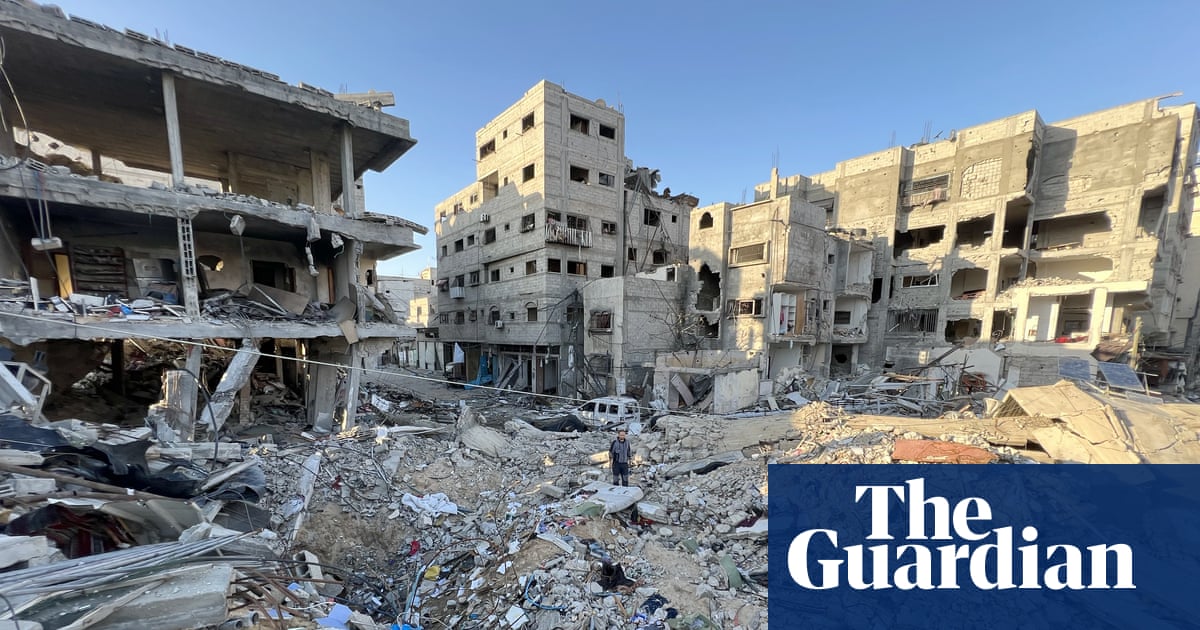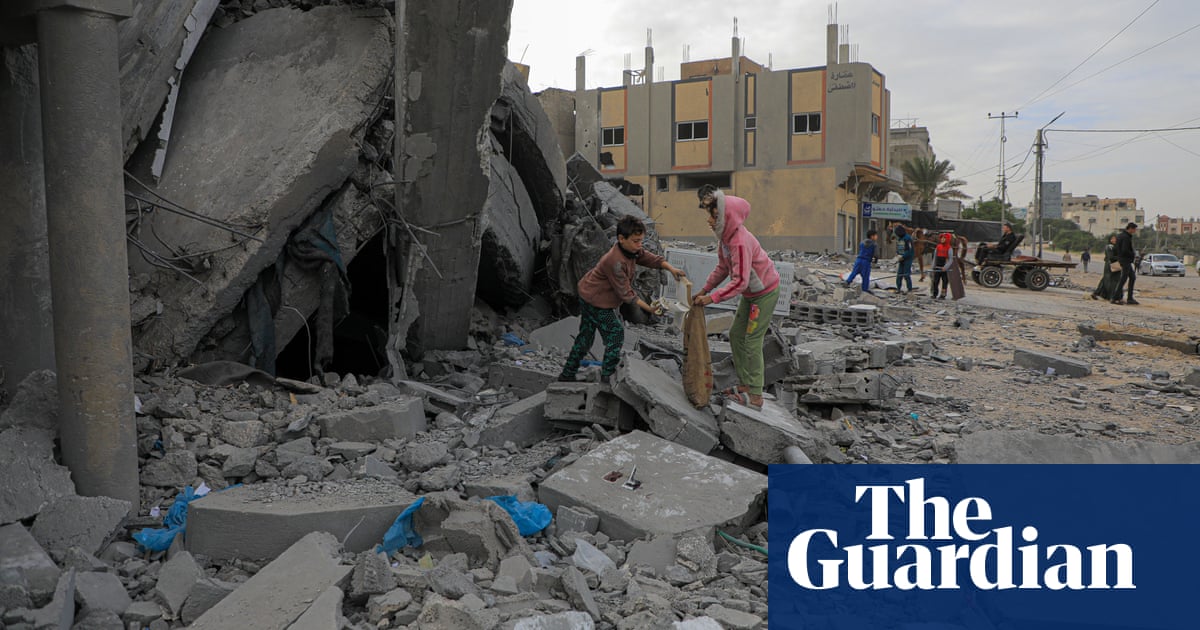
The destruction of more than a third of Gaza’s homes as Israel bombards the territory in pursuit of Hamas is leading international legal experts to raise the concept of “domicide” – the mass destruction of dwellings to make the territory uninhabitable.
In the current Gaza war, launched after the 7 October attack by Hamas on southern Israel, independent experts estimate that as much as 40% of the housing in Gaza has been damaged or destroyed. The UN says 1.8 million people are internally displaced inside Gaza, many living in overcrowded UN shelters in the south.
Although Gaza has been damaged in previous conflicts and rebuilt, largely with money from the Gulf states, the current scale of the devastation is of a different order.
At issue is whether the scale of the infrastructure damage is a byproduct of the search for Hamas or part of a covert plan to expel Palestinians from Gaza, erasing the possibility of Gaza becoming a semi-viable society in the foreseeable future.
Domicide, a concept increasingly accepted in academia, is not a distinct crime against humanity under international law, and the UN special rapporteur on the right to housing tabled a report to the UN in October last year arguing that “a very important protection gap” needed to be filled.
The destruction of homes in Aleppo in the Syrian civil war, the flattening of Rohingya settlements in Myanmar and the destruction of Mariupol in Ukraine have in recent years increased focus on the issue.
“It is necessary to address hostilities being carried out in the knowledge that they will systematically destroy and damage civilian housing and infrastructure, rendering an entire city – such as Gaza City – uninhabitable for civilians,” the UN rapporteur, Balakrishnan Rajagopal, a law professor at the Massachusetts Institute of Technology in Boston, told the Guardian.
Rajagopal argues that a gap exists in international law since while the protection of civilian homes is covered by the Rome statute establishing the international criminal court in relation to war crimes in conflicts between states, it is not listed as among the crimes against humanity that could take place in a conflict within a state or involving non-state actors.
“This is relevant to the mass destruction of housing in the case of the Israel-Palestinian conflict in Gaza,” Rajagopal said. “Israel will say the conflict is not an international armed conflict because Israel does not recognise Palestine as a state.”
He argued that most of the conflicts where the most deaths have occurred since the second world war have been non-international armed conflicts, with the conflict between Russia and Ukraine an exception rather than the rule.
He said a similar gap in relation to starvation had just been filled. The Rome statute had listed starvation as a war crime but not a crime against humanity, so exempting non-state actors. Switzerland pressed to amend the statute to make starvation a crime against humanity, a change finally implemented in 2022.
Rajagopal said: “I would appeal to these countries that oppose what is happening in Gaza, such as South Africa and Spain, to do exactly what they did with regard to starvation to address the protection gap [and] make sure the mass destruction of housing in Gaza can be prosecuted.”
He added that on the basis of the facts and remarks made by Israeli leaders, he believed the purpose of the destruction on this scale was not simply to eliminate Hamas but to make Gaza uninhabitable.
Israel says all damage to buildings and loss of civilian life is regrettable but made necessary by Hamas deliberately hiding in schools and hospitals and by its refusal to surrender. It says it is making every effort to warn citizens of imminent attacks.
Estimates of the level of destruction of Gaza’s buildings are contentious but new use of satellite imagery suggests that 98,000 buildings had been damaged as of 29 November, the start of the now abandoned temporary ceasefire.
The findings were based on analysis of European Space Agency Copernicus Sentinel-1 satellite data by Corey Scher of the City University of New York and Jamon van den Hoek of Oregon State University. Their work has been repeatedly cited by news organisations ranging from the BBC to the Washington Post, reflecting the difficulty reporters have in mapping the true scale of the bombing.
Rather than using optical images, the assessment relies on publicly available satellite radar data and a specifically developed algorithm to measure the stability of the built environment to infer building damage. It has the advantage of looking at structures from oblique angles and not just overhead.
The imagery moving north to south showed 47% to 59% damage between 7 October and 22 November in northern Gaza, 47-58% damage in Gaza City, 11-16% in Deir al-Balah, 10-15% in Khan Younis and 7-11% in Rafah, the area closest to the border with Egypt. This amounts to between 67,000 and 88,000 buildings, meaning roughly 70% of buildings remain undamaged. The figure for Khan Younis will have risen since the end of the ceasefire and the concentration of Israeli military activity in the south.
Among the buildings destroyed or partially destroyed are the main Palestinian court in Gaza, known as the Justice Palace, the Palestinian Legislative Council complex, 339 education facilities and 167 places of worship, while 26 of the territory’s 35 hospitals are not functioning.
Hugh Lovatt, of the European Council on Foreign Relations, suggested Israel was “deliberately and methodically destroying the civil institutions and infrastructure that will be needed to govern and stabilise post-conflict Gaza”.
Satellite imagery also reveals the destruction of orchards, greenhouses and farmland in northern Gaza. Human Rights Watch said on Monday: “In north-east Gaza, north of Beit Hanoun, once green agricultural land is now brown and desolate. Fields and orchards were first damaged during hostilities following Israel’s ground invasion in late October. Bulldozers carved new roads, clearing the way for Israeli military vehicles.”
Leaks from inside the Israeli government, including the intelligence ministry, show officials have been examining ways to force Palestinians to leave Gaza, either voluntarily or forcibly. The intelligence ministry is not a high-status body in the government, but US conservatives such as John Bolton, the former national security adviser, have canvassed variations of such plans.
Giora Eiland, a former head of the Israeli national security council, wrote in Yedioth Ahronoth, an Israeli newspaper: “The state of Israel has no choice but to turn Gaza into a place that is temporarily or permanently impossible to live in. Creating a severe humanitarian crisis in Gaza is a necessary means to achieve the goal … Gaza will become a place where no human being can exist.”
The US has repeatedly ruled out such a policy, partly because it knows two allies, Jordan and Egypt, will not welcome more refugees into their countries, even on a temporary basis.










